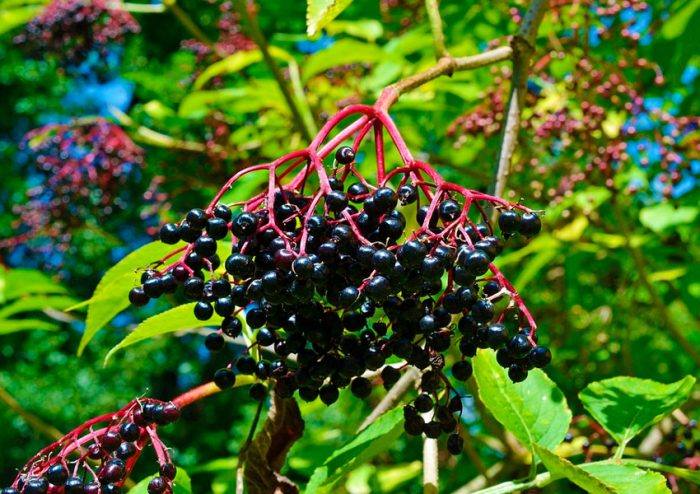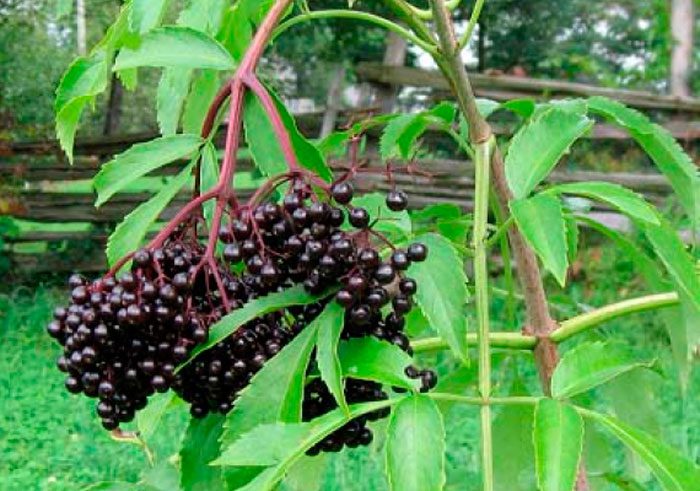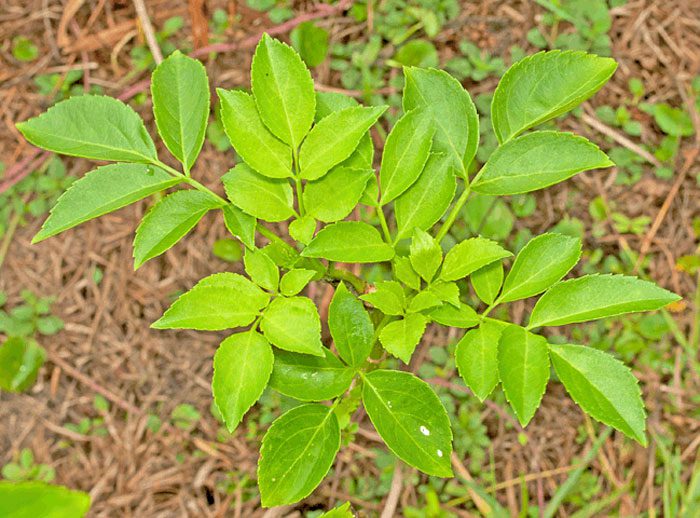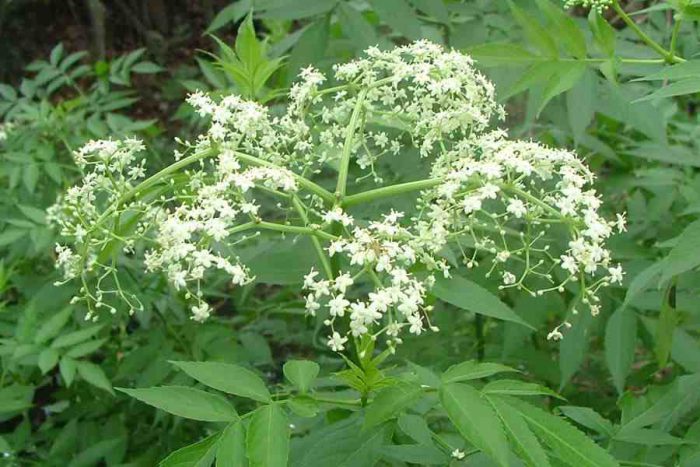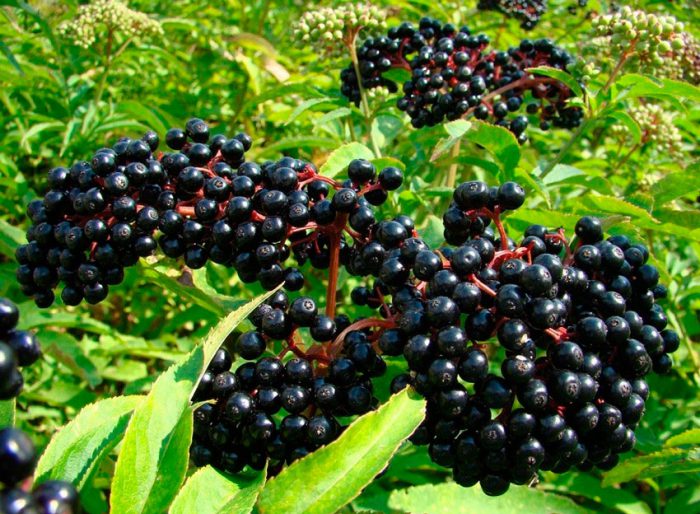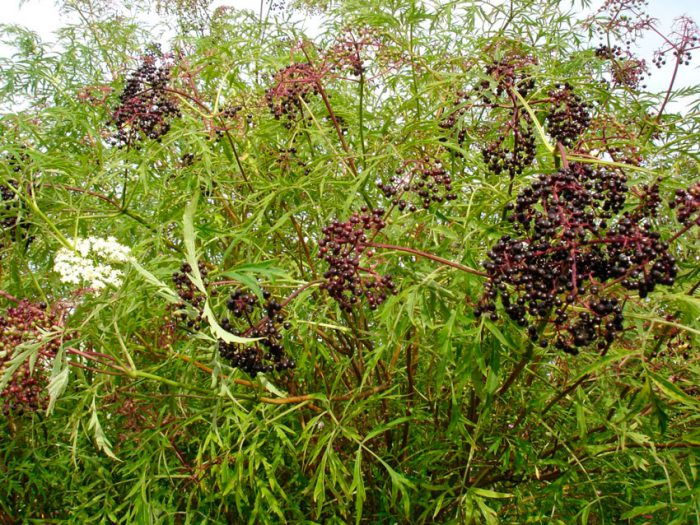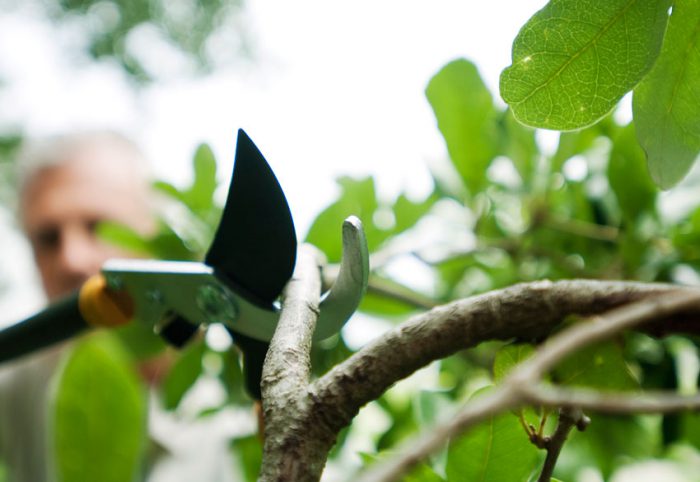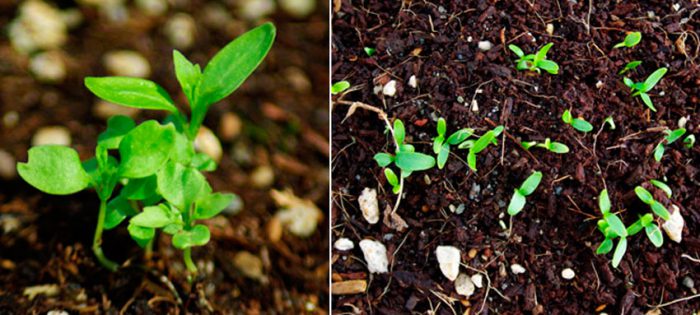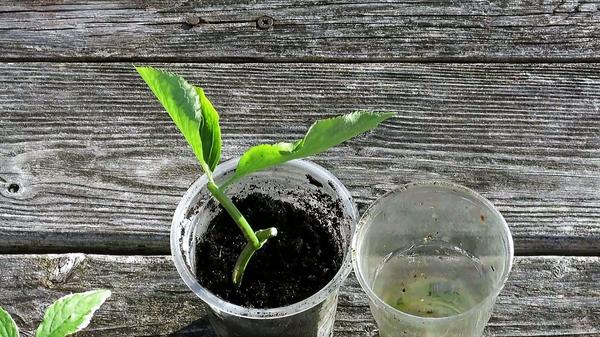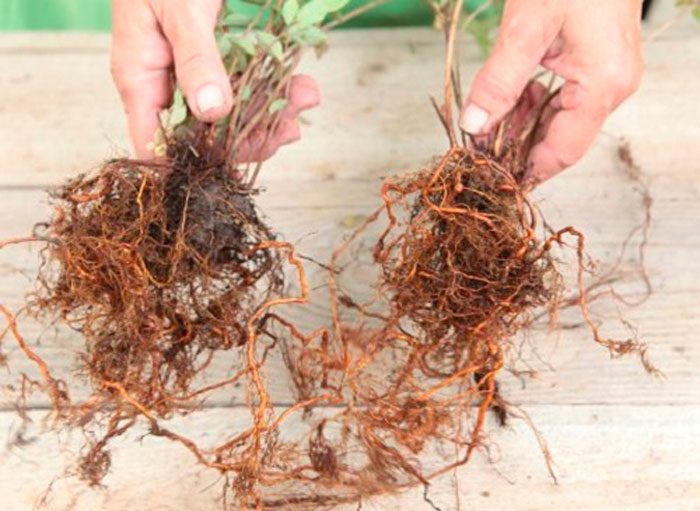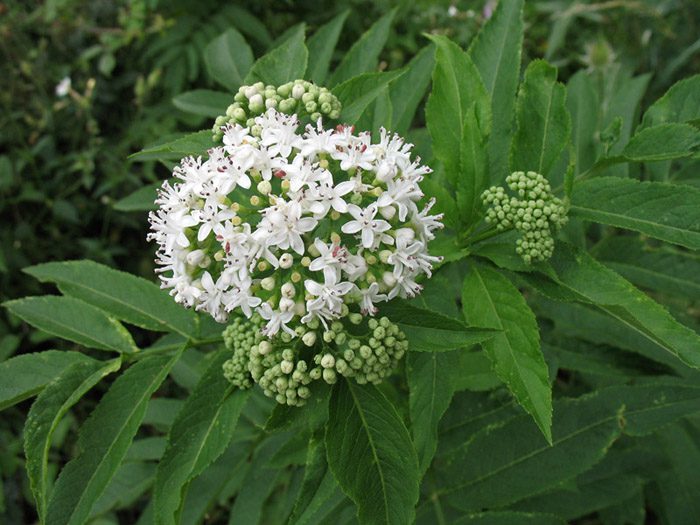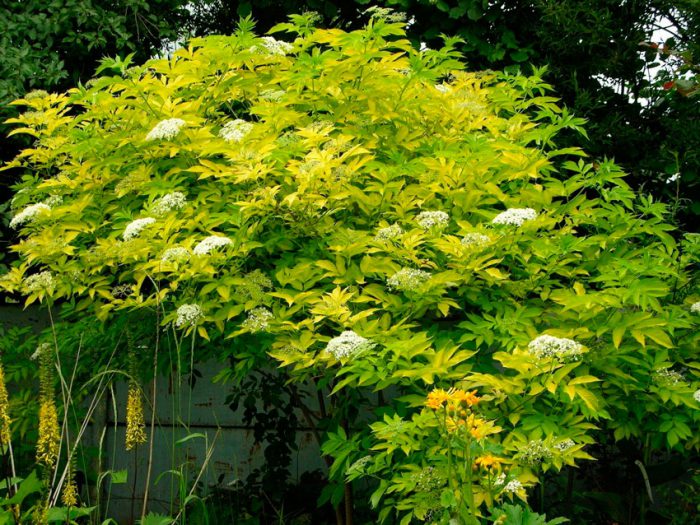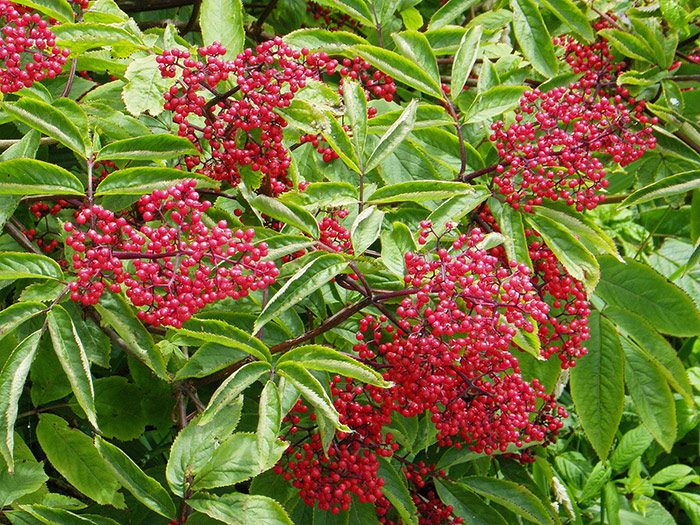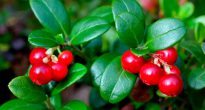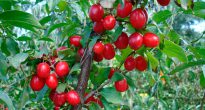The elderberry plant (Sambucus) is a shrub and belongs to the genus of flowering plants of the adox family. However, before that, this plant was considered a representative of the honeysuckle family, and it was also isolated into a separate elder family. This genus unites about 40 species, some of which are considered decorative, and there are also medicinal ones, for example, red elderberry and black elderberry. In the wild, such a shrub can most often be found in regions with a subtropical and temperate climate of the Northern Hemisphere, as well as in Australia. Man learned about the existence of elderberry in ancient times. So, the ancient Greeks made musical instruments from the shoots of such a plant, and there is also a mention of it in the writings of Pliny.
Content
Elderberry features
Elderberry is most often represented by not very large trees or shrubs, but there are also perennial herbaceous plants in the genus, for example, herbaceous elderberry. In the middle latitudes, only 13 elderberry species are grown. And the most popular among gardeners of these latitudes is the black elderberry, which will be described in great detail below.
Black elderberry is represented by not very large trees or shrubs, like most of the species in this genus. The plant can reach a height of 2–6 meters, in nature it prefers to grow in the undergrowth of coniferous and deciduous forests, in some cases it creates dense thickets. Branched shoots have a thin woody sheath, while their white core is soft and porous. The color of young branches is green, it eventually changes to grayish brown with many very small lentils. The length of large leaf plates reaches 10-30 centimeters. They are imparipinnate, they include several long-pointed oblong leaves opposite and short-petiolate.The diameter of large multi-flowered flat corymbose inflorescences is 0.25 m, they consist of fragrant, dirty yellow or cream-colored medium-sized (diameter 0.5-0.8 cm) flowers. Flowering begins in May or June. The fruit is a berry-shaped drupe of almost black color, its diameter is about 0.7 cm, the pulp is dark red, there are from 2 to 4 seeds. The beginning of fruiting occurs in August – September.
Elderberry is not only an ornamental plant, it also has healing properties.
Planting elderberries in open ground
What time to plant
Planting an elderberry is quite simple, because this process is slightly different from planting other shrubs in open ground. Disembarkation can be done in spring and autumn. Experts recommend choosing those seedlings for planting that are 1 or 2 years old. Despite the fact that this plant is distinguished by its unpretentiousness, it cannot be grown in poor soil or in the shade, since this will not be the best way to affect the decorative effect of the bush and its growth and development. For planting, you should choose an open sunny area located on the east or north side of the garden. Remember that an elderberry variety with variegated or colored foliage needs a lot of sunlight. Young shoots of elderberry have an unpleasant aroma that even flies cannot tolerate, therefore such a plant is often planted near compost or cesspools and toilets.
It is recommended to plant such a shrub in sod-podzolic soil or moist loam with a pH of 6.0–6.5. If the soil is acidic, then a couple of years before planting the elderberry it is necessary to subject it to liming, for this purpose dolomite flour is added to it.
Spring planting
When planting a seedling of such a plant in spring, prepare the planting hole 4 weeks before planting. It should be borne in mind that the depth of the hole should be 0.8 m, and its width - 0.5 m. While you dig the hole, the nutritious upper and lower poor soil layer will need to be thrown in different directions. In the event that you want to give the plant the shape of a tree, then find the center of the bottom of the hole and install a stake in it so long that it rises 50 centimeters above the soil surface after planting. If the elderberry will be cultivated as a shrub, then you do not need to make a support for it. The top layer of soil must be combined with 30 grams of potash fertilizers, 50 grams of phosphates, as well as 7–8 kilograms of humus. The resulting substrate must be mixed very well. 2/3 of this mixture must be poured into the pit.
During the planting of the seedling, it will be necessary to thoroughly loosen the top layer of the substrate poured into the pit. Then the seedling itself must be installed in the pit. Its root system should be covered with a lower layer of soil, and then the hole is filled to the top with the remaining soil mixture. In a planted plant, the root collar should rise several centimeters above the soil surface. After the soil in the near-stem circle is well compacted, water the plant with 1–1.5 buckets of water. When the liquid is completely absorbed and the soil settles, the root collar of the seedling should be flush with the soil surface. At the very end, if necessary, the elderberry is tied to a peg.
Autumn planting
It is necessary to plant a seedling of this plant in autumn in the same way as in spring. The preparation of the planting pit must be done in advance; the necessary mineral and organic fertilizers must be added to it. When planting a seedling, remember that after watering and settling the soil, its root collar must necessarily be at the same level with the soil surface.
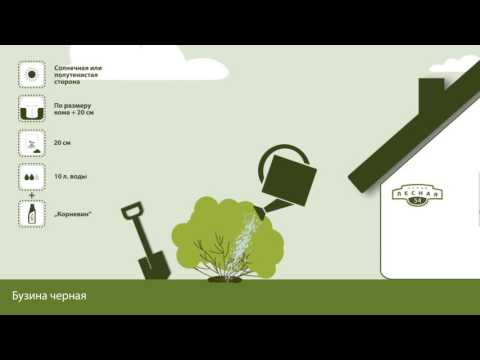

Watch this video on YouTube
Elderberry care
How to groom in spring
In March, there is a high probability of sunburn on the surface of the elderberry bark. The fact is that in the daytime, due to very bright sunlight, the crust is heated strongly, and at night it cools sharply. To avoid the appearance of burns, it is enough to paint the base of the skeletal branches and the stem of the plant with lime. In the event that the bark of the plant was injured by rodents in winter, then such places must be disinfected with a sufficiently strong solution of potassium manganese, then they are treated with garden varnish.
Choose a warm enough sunny day and prune the elderberry. Then the bush should be sprayed in order to prevent diseases and pests with a solution of Bordeaux liquid or Nitrafen. Remove the insulating material and last year's fallen leaves from the surface of the trunk circle. If in the winter there was very little snow, and the spring turned out to be dry, then the plant will need water-charging watering.
How to care in summer
When the plant fades, it will be necessary to carry out preventive treatment against powdery mildew and pests.
In the first summer weeks, the elderberry begins to form ovaries and grow intensively. In this regard, at this time, it is very important that the plants have enough water and nutrients. Remember that the surface of the trunk circle should be moist and loose all the time. If the plant was damaged by frost in the winter, then in the spring it has a rather rapid growth of root shoots. This growth should be removed as soon as it appears, since it can very quickly overtake the plant itself in growth. In order to prevent the uncontrolled spread of elderberry over the garden plot, it is necessary to step back 1.5 meters from the bush and dig in the old slate sheets in a circle, burying them 50 centimeters into the soil.
In August, some varieties of elderberry begin to ripen their fruits, so you should be ready to harvest. You should start preparing the plant for the winter period already in the last summer weeks. If there was a lot of rain in the summer, then this can cause the growth of secondary shoots. To stop this, it is necessary to remove the mulching layer from the surface of the trunk circle and pinch the tops of the growing stems.
Autumn care
In the fall, it is very important to prepare the elderberry for wintering. In September, berries are harvested, and then sanitary pruning of the plant. In the last days of September, it is necessary to dig the soil in the trunk circle, during which fertilizers are applied. If there is little rain in the autumn, then the plant will need winter watering. In the event that the planting of seedlings is only planned, then in the last days of September it is necessary to make a planting hole and add all the necessary fertilizers to it.
It is necessary to spray the bark of the elderberry and the surface of the trunk circle in order to destroy pests and pathogenic microorganisms in October. Large branches and trunks must be whitewashed with chalk mixed with wood glue and copper sulfate or freshly slaked lime. Thus, you will provide the plant with protection from spring burns and rodents. The surface of the trunk circle must be covered with a layer of humus, peat or dried foliage.
To protect the shrub from frost, it is necessary to throw a layer of freshly fallen snow under the plant.
Treatment
Preventive treatment of bushes and the surface of the trunk circle from diseases and pests is carried out 2 times a year, namely: in the spring before the buds open and in the fall, when all the leaves fall off. For spraying, use a solution of Nitrafen (2-3%) or Bordeaux liquid (1%). You can replace these funds with a solution of copper sulfate (1%) or another preparation of a similar action. In spring, it is recommended to use a urea solution (7%) for spraying elderberry, this will not only destroy pathogens and pests, but also feed the plant with nitrogen,after all, he needs this substance at this time of the year.
How to water properly
If there is a lot of rain in the summer, then you do not need to water the elderberry. Also, the mulching layer on the surface of the trunk circle significantly reduces the amount of watering, as it prevents the rapid evaporation of water from the soil. It is recommended to use rotted manure or compost as mulch. If there is a prolonged drought in the summer, then such a plant should be watered once every 7 days, while 1-1.5 buckets of water are poured under 1 bush. If there is a lot of rain in the summer, the elderberry can do without watering. Younger bushes will need more frequent watering. Remember that the soil in the trunk circle should never dry out. When the elderberry is watered or it rains, you need to loosen the surface of the trunk circle, while pulling out all the weeds.
Fertilizer
If the soil on the site is saturated with nutrients, then the elderberry can do without dressing. If the soil is poor, then in spring and summer, experts advise to apply nitrogen-containing fertilizers into it, which will have a positive effect on the growth and development of the plant. Elderberries can also be fed with organic matter, while it is best to use chicken manure and slurry for this. Also, for fertilizing, you can use a complex mineral fertilizer and urea. Remember that you cannot feed the plant in autumn.
Elderberry pruning
Sanitary and shaping pruning should be done every year. Rejuvenating pruning is done once every 3 years, while all branches must be shortened to a height of 10 centimeters. Pruning is recommended when the plant has a dormant period. This time falls at the beginning of the spring period (before the swelling of the buds). In some cases, after harvesting the berries and the fall of all the foliage, sanitary pruning is performed in the autumn.
Pruning elderberry in spring
In a seedling planted in open ground, on the same day, the stems are shortened by 10 centimeters per strong external bud. The natural shape of the crown of such a plant is oval and neat enough, so the gardener will only have to timely remove those branches and shoots that grow in the wrong direction or inside the bush. You should also cut out any dry, weak, damaged by frost or disease stems. As soon as the root growth appears on the soil surface, it must be cut out immediately. Every year ¼ of the old branches should be cut to the base of the plant. Do not forget that the cuts must be processed with garden varnish.
Pruning elderberry in autumn
When harvesting is complete, inspect the plant. If there are a large number of injured branches, then sanitary pruning will be required. At the same time, along with the injured branches, you can cut out those that grow inside the bush and are damaged by the disease. But remember that autumn pruning is done only when necessary.
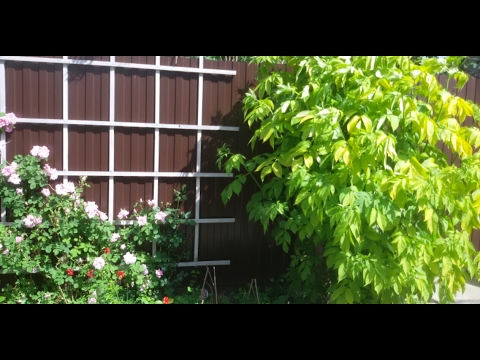

Watch this video on YouTube
Elderberry propagation
Elderberry can be propagated by seed, as well as vegetative - dividing the bush, cuttings and layering. Gardeners, as a rule, resort to vegetative propagation methods, because seedlings grown from seeds almost never retain either the varietal or species characteristics of the parent plant.
How to grow from seeds
In the autumn (in mid-October), you will need to extract seeds from ripe fruits, for this they are rubbed through a sieve. Seeds are sown in rows, between which a distance of 0.25 m should be maintained. Seeds should be deepened into the soil by 20-30 centimeters. By the next autumn, the height of the grown seedlings will reach 0.5–0.6 m.
Elderberry propagation by cuttings
Harvesting green cuttings is done in June or in the first days of July.The length of the cuttings should be from 10 to 12 centimeters and they should have 2 or 3 internodes and 1 pair of upper leaf plates, while only 2 paired segments should be left on their petiole. They are planted in a substrate consisting of peat and sand (1: 1). Greenhouse conditions will be needed to root the cuttings, so they must be covered with a polyethylene bag on top. In order to increase the ability of cuttings to form roots by 2 or 3 times, it is necessary to dip the lower sections in a preparation that improves root formation immediately before planting in the substrate. In the first 4–6 days, the cuttings will need a very high air humidity, so the inner surface of the bag will need to be systematically moistened from a fine atomizer. At the same time, try to prevent water droplets from falling on the surface of the leaf plates, as this can cause rot on them. By the onset of the autumn period, the cuttings will have to take root, and they can be planted in open soil in a permanent place.
If there is a desire, then you can propagate the elderberry with one-year-old lignified cuttings. They are harvested at the end of the growing season. In winter, they can be stored in the basement or buried in the snow. In spring, they are planted in nutritious loose soil in the garden. In this case, each of the cuttings should be covered from above with a transparent glass jar or a cut plastic bottle. Such a shelter is removed only after the rooting of the cuttings.
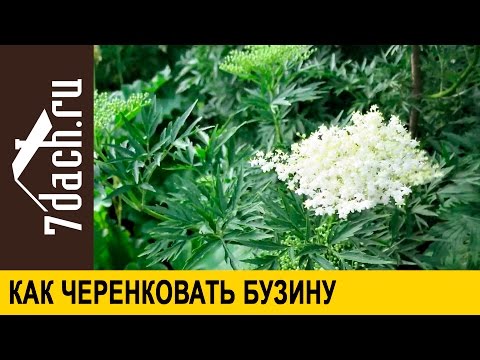

Watch this video on YouTube
Elderberry propagation by layering
When propagating by this method, 10 layers out of 10 almost always take root. To obtain a layer, you should choose a two or three-year lignified or young green shoot. It must be bent to the surface of the site and laid in the groove, which is made in advance. Secure the shoot in this position with a metal hook. Then the shoot is instilled in such a way that its top remains free.
It blows away to remember that the lignified layer at the base must be dragged with wire. If you lay the shoots in the grooves in May or the first summer weeks, then the rooted layers can be cut off from the bush in the fall and planted in a permanent place. Green shoots are not tied with wire, and it will be possible to cut them off from the parent bush only the next year after they become lignified.
How to propagate by dividing a bush
Elderberry can be propagated by dividing the bush in autumn. To do this, you need to remove a large adult bush from the soil. It is divided into several equal parts. Cutting the root system of such a plant is quite difficult, so it is recommended to use a saw or an ax. All plots should have well-developed stems and roots. Places of cuts and cuts must be sprinkled with wood ash, then the divisions are seated in permanent places. If desired, they can be planted in large containers, and transplanted into the garden only next spring. With this method of reproduction, the gardener gets several large bushes at once.
Diseases and pests
Elderberry is very resistant to pests and diseases. Very rarely, green aphids can settle on a bush. To prevent this from happening, in the springtime, they carry out a preventive treatment of the plant with Karbofos, while you must adhere to the instructions on the package.
Types and varieties of elderberry with photos and names
As mentioned above, the black elderberry is the most popular among mid-latitude gardeners. In addition to this plant, about 10 different species of elderberry are cultivated in such latitudes, which will be described below.
Blue elderberry
This plant is decorative.Under natural conditions, it can be found in North America, while it prefers to grow in mountain pastures and along the banks of rivers and streams. In this species, the height of the trees does not exceed 15 meters. Sometimes there are shrubs with thin branches that have a red color at a young age. The color of the trunks is pale sandy. The leaf blades include from 5 to 7 coarsely serrated greenish-blue leaves, which reach about 15 centimeters in length. The diameter of the corymbose-shaped inflorescences is about 15 centimeters, they consist of fragrant cream-colored flowers. Flowering lasts approximately 20 days. The fruits have a spectacular appearance, their shape is spherical, and the color is bluish-black, because there is a bluish bloom on the surface of the berries. Winter hardiness in this species is below average.
Siberian elder
Under natural conditions, such a species can be found in the European part of Russia, the Far East, East Asia, and Western and Eastern Siberia. This plant prefers to grow in dark coniferous and mixed forests, while they can be found at an altitude of up to 2200 meters above sea level. This ornamental shrub reaches a height of 4 meters, it is distinguished by an average frost resistance.
Herbaceous elderberry
In nature, this species can be found in Belarus, Ukraine, the Caucasus and the south of the European part of Russia; this elderberry prefers to grow along river banks and on rocky talus. The height of such a herbaceous plant reaches 150 centimeters, an unpleasant smell emanates from it, but it looks very impressive during flowering and fruiting. Fruits form shields at the tops of the stems. Remember that fresh fruits are poisonous because they contain hydrocyanic acid. In some cases, such plants are planted around the currant, because it can scare away the kidney mite and all harmful butterflies. But it is worth considering that if you want to get rid of the elderberry later, it will be extremely difficult to do, since it has a thick creeping rhizome. Dried flowers of this type have a pleasant aroma; they are often used to pour apples during storage.
Elder canadian
In the wild, this species is found in eastern North America, while it prefers to grow in moist nitrogen-rich soil. This elderberry is highly decorative and is often used for landscaping garden plots. The height of the bush is about 4 meters. The color of the stems is gray-yellow. The length of large leaf plates is about 0.3 m. Slightly convex umbellate inflorescences reach 0.25 m in diameter, they consist of small fragrant whitish-yellow flowers. Glossy berries are globular and dark purple in color and can be eaten. The species has been cultivated since 1761. Externally, the bush is similar to the black elderberry, but this species is more suitable for growing in mid-latitudes. Decorative forms:
- maxim - this form is the most powerful of all;
- acutiloba ―slender bush has strongly dissected leaf plates;
- chlorocarp - the fruits are green, and the color of the foliage is greenish-yellow;
- aurea - foliage is green in summer, and rich yellow in autumn and spring.
Elderberry racemose or red
The homeland of this type is the mountains of Western Europe. This species is represented by a small tree, the height of which does not exceed 500 centimeters, and a deciduous shrub with a dense ovoid crown. The length of unpaired leaf plates is about 16 centimeters, they are painted in a pale green color, they include from 5 to 7 leaves, pointed and elongated, on the edge of which there are sharp teeth. The diameter of the lush oblong inflorescences is about 60 mm, they consist of yellow-green flowers. The fruit is a small deep red berry. The branches and leaf plates of the plant have an unpleasant odor.This elderberry looks most impressive during fruiting. Cultivated since 1596. Decorative forms:
- Low... The bush is compact, dwarf.
- Thin-leaved... During the opening, the leaf plates are colored purple, they are cut into narrow segments, this is the reason for the graceful appearance of the bush.
- Purple... The color of the flowers is pink or purple.
- Yellowish... The barrels of yellow berries are colored orange.
- Dissected... This type of elder racemose is the most popular among gardeners. Large leaf blades open very early; they consist of 2 or 3 pairs of finely dissected leaves.
- Plumose... During opening, the serrated leaves are colored purple, they are cut almost to the middle. Popular varieties of this variety:
- Plumosa Aurea Shaded leaf plates are green in shade, and yellow in the light;
- Sutherland Gold - yellow leaf plates are even more dissected.
Elder Siebold
In the wild, this species can be found in the Kuril Islands, the Far East, Sakhalin and Japan. In Western Europe, it is cultivated as an ornamental plant. This species is represented by a spreading shrub or tree, reaching a height of 8 meters. Outwardly, the appearance is similar to the red elderberry, but the Zimbold elder is more powerful. The composition of the sheet plates includes 5-11 parts. The leaves are about 20 centimeters long and 6 centimeters wide. Compared to the red elderberry, the inflorescences are larger, but less dense. Cultivated since 1907. Black elderberry, the description of which is presented at the beginning of the article, also has several decorative forms: Most often, decorative forms are less resistant to frost, but they have a more spectacular appearance, they are planted in the garden as a tapeworm or in a group with other plants. The following useful substances can be found in elderberry inflorescences: valerian, acetic, coffee, malic and chlorogenic organic acids, tannins, semi-solid essential oil, choline, carotene (provitamin A), mucous and paraffin-like substances, sugars. The flowers of this plant have unique properties. The fruits contain ascorbic acid (vitamin C), carotene, malic acid, resin, glucose, fructose, amino acids and dyes. Carotene and ascorbic acid, essential oil, tannins, resinous substances can be found in fresh black elderberry foliage, and provitamin A1 in dried leaves. The bark contains choline, essential oil and phytosterol. An infusion is prepared from the dried fruits (1:10). It stimulates bile excretion, enhances intestinal motility and urine output. With the flowers of this plant, tea is prepared, used for laryngitis, flu, bronchitis and neuralgia. It is also used to rinse the mouth as an anti-inflammatory agent. Alternative medicine uses bark, foliage, elderberry fruits and flowers.Broths and infusions made from elderberry color are used as an antibacterial and diaphoretic agent, which is still used in the treatment of influenza, colds, tonsillitis and other diseases of the upper respiratory tract. In order to prepare an infusion of black elderberry color, you need 1 tbsp. Combine hot water with 1 large spoon of dried flowers. The mixture is boiled over low heat for a quarter of an hour. The cooled infusion must be filtered and squeezed out. It is taken at 100 mg 2 or 3 times a day for gout, rheumatism or arthritis. The flowers are used to prepare a lotion that has a rejuvenating and skin toning effect. 1 tbsp. Freshly boiled water must be combined with 5 elderberry inflorescences, let the mixture stand for 24 hours. The strained lotion is stored in the refrigerator. The foliage of such a plant has a sedative, laxative, astringent, diuretic and antipyretic effect. Steamed leaves are used externally for hemorrhoids, burns, diaper rash and boils. The foliage boiled in honey is used in the treatment of constipation. A decoction made from the bark of such a plant is used during the treatment of gout, arthritis, rheumatism, skin and kidney diseases. Elderberry is also used to make jelly, preserves and wines. It should be remembered that the berries of the red elderberry are not suitable for eating, moreover, if you touch them with your hands, wash them thoroughly with detergent. If the juice of such fruits gets into cracks in the mucous membrane or wounds on the skin, then you need to consult a doctor for help as soon as possible. Experts advise women to refrain from eating black elderberry fruits during pregnancy, as well as to people with diabetes, colitis, or those suffering from chronic stomach diseases. Also, elderberry should not be consumed with individual intolerance and with Crohn's disease. If you do not know what kind of elderberry is in front of you, then be sure to remember that, to a certain degree of ripeness, the fruits of black and red elderberries can be very similar.

Black elderberry properties: benefits and harms
The healing properties of black elderberry
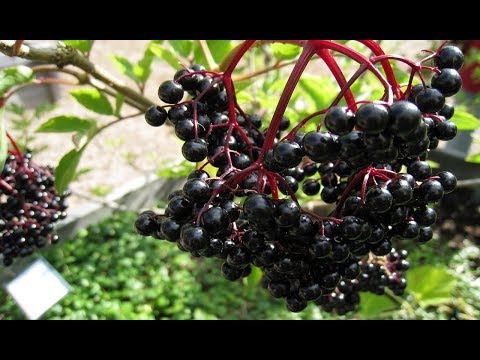

Watch this video on YouTubeContraindications

